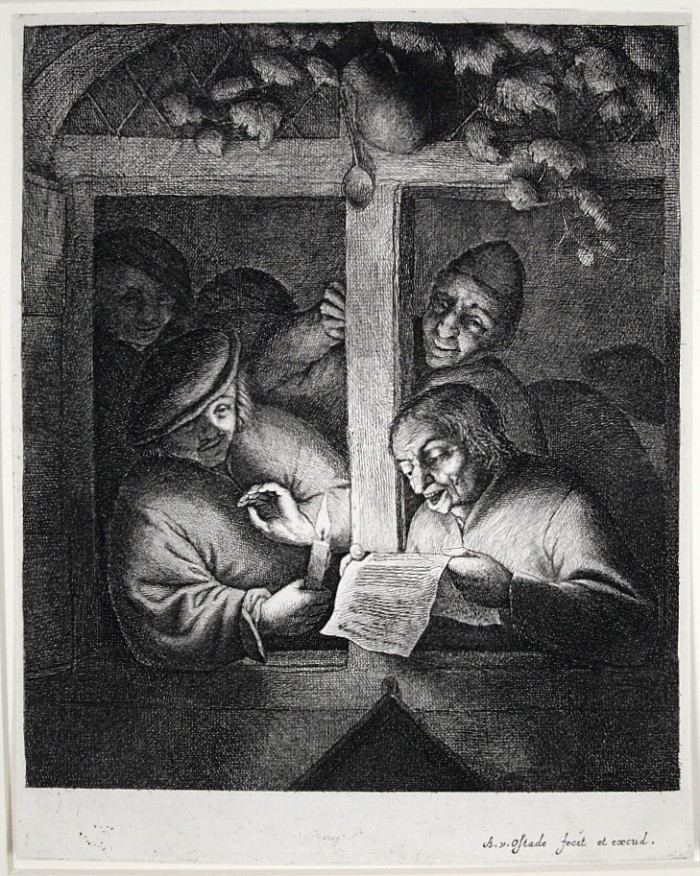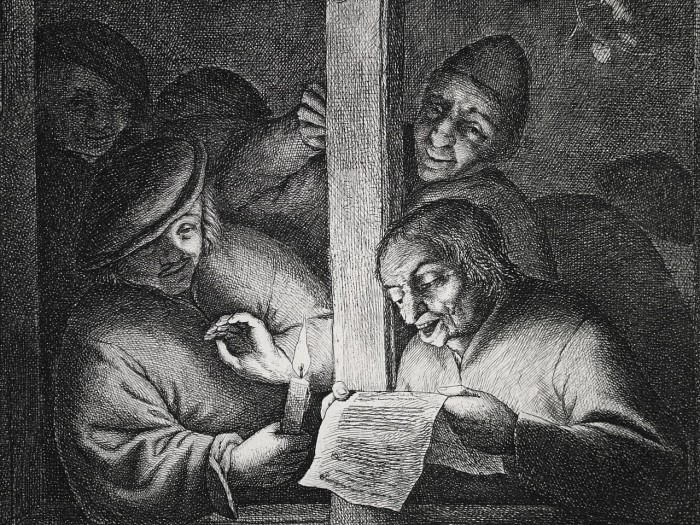The Singers – 5th State

Adriaen Van Ostade, The Singers, circa 1668, etching. References: Godefry, Hollstein 19. The fifth state (of seven). In very good condition. [with the inscription on the plate [A. v. oftade fecit et excud.]. With margins, 9 7/16 x 7 17/32, the sheet 9 17/32 x 7 19/32 inches. On old laid paper.
Provenance: Craddock and Barnard, London, acquired on December 8, 1967 by Dr. S. W. Pelletier (with his stamp verso, Lugt 4193). Dr. Pelletier was known for his fine collection of Van Ostade etchings (as well as superb examples of etchings by Rembrandt, Van Dyke, Meryon, and others).
A fine impression in black ink on ivory laid paper, with superb contrasts.
In this state the three vertical lines above the jug are crossed by three diagonal strokes, also appearing in the margin, before the scratch on the nose of the standing man). Dr. Pelletier notes that Godefry is not correct in stating that state V is a Picart (and thus possibly posthumous) printing; and that the Picart is of state VI (cf. Adriaen Van Ostade, Etcher of Peasant Life in Holland’s Golden Age, pp. 109-110. This impression is illustrated in this volume, p. 106).
Further data on this and other Van Ostade prints, in the exhibition catalog for the 1998 exhibition at the Rembrandthuis, Everyday Life in Holland’s Golden Age: The Complete Etchings of Adriaen van Ostade, sheds additional light on the dating of this impression. Laurentius points out, based on watermark evidence, that there were posthumous printings of Van Ostade prints in the period 1685-1700, probably by Gole, and indeed, that Picart may not have printed/published a posthumous edition at all. In the initial essay in the catalogue Pelletier revises his ’94 opinion that this impression is definitely lifetime in light of Laurentius’s conclusion that the print in this state is found in the posthumous editions. Pelletier notes, however, that “In some cases impressions of a Picart-Gole state are still in the condition left by Van Ostade. My own studies indicate that the following fifteen etchings, in the states corresponding to those in the Picart-Gole edition, do not contain the characteristic fine, close, parallel strokes, and therefore probably exist in lifetime impressions: B. 1,2,5,6,8,10,13,16,19,20,24,27,33,40, and 41.” He then gives examples of Mariette-dated prints that were in lifetime states but the same states in the posthumous edition(s). (Slatkes also notes that whomever produced the early posthumous edition re-worked only those plates which were especially worn.) Laurentius points out that a number of the etchings examined did not have watermarks. Watermark evidence would shed light on the lifetime status of this impression but unfortunately, without the watermark evidence, we can not conclude with certainty that this is not (or is) a lifetime impression (and we can not find a watermark on this impression, nor could Pelletier).
The Singers is one of Van Ostade’s most important and impressive works. It shows four singers, three of whom are highlighted by the candlelight held by the man at the left; a fourth man is in the shadows upper left, and other shapes, suggesting figures, lurk in the background as well.
The Singers probably depicts members of a rhetorical group; these groups were common in The Netherlands during the late 15th and 16th centuries (there were two in Haarlem at the time, and many local artists such as Frans Hals and Esaias van de Velde, were members). Their members presented public readings, plays, and sponsored literary competitions. Jan Steen created well-known paintings of such a group (at Worcester and Philadelphia), probably after Van Ostade’s conception. Van Ostade as well made several drawings and a watercolor on the subject, and probably at least one painting (now lost). The triangular shape at the bottom of the etching is surely the upper half of a “blazon” or coat of arms that these rhetorical groups used to identify themselves.

Detail